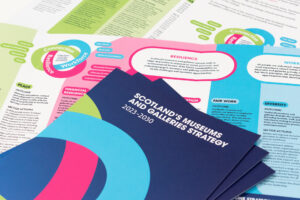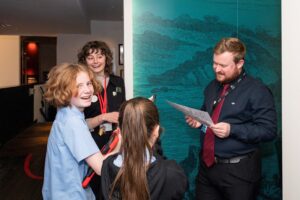Building on the success of the Strategy Symposium
Lucy Casot, CEO of Museums Galleries Scotland, reflects on the key themes which emerged from Scotland’s Museums and Galleries Strategy Symposium 2024 and calls for museums and galleries to share feedback about their progress on the aims of the strategy.

Introduction
It was a real pleasure to welcome so many museums, galleries, and key partners to Scotland’s Museums and Galleries Strategy Symposium in person and online last week.
As we gathered at the National Museum of Scotland for a series of panels and workshops, I was inspired by the energy and enthusiasm in the room. There was a sense of celebration as museums and galleries showcased the progress they’ve made, despite the challenges faced by many, towards our shared ambitions for a more innovative, inclusive, and impactful museum sector.
One week on from the Symposium, I’ve had a chance not only to reflect on its success but also to consider the next steps for both Museums Galleries Scotland and the museum sector as we continue in our collective efforts to achieve the aims of Scotland’s Museums and Galleries Strategy.
The talks, presentations, and networking opportunities at the Symposium all served to highlight the relevance of the strategy’s three core themes – connection, resilience, and workforce – to our priorities as a sector.
Museums and galleries are at their best when they connect with their audiences. The same is true for Museums Galleries Scotland. We found it incredibly valuable to meet with museum sector workers and key partners at the Symposium: together, we forged connections, identified opportunities, and explored ways to navigate the shared challenges that we face as a sector.
A personal highlight was welcoming Kaukab Stewart MSP to the Symposium for her first public engagement as Minister for Culture, Europe, and International Development. In her opening address, she drew on her own experience of visiting Kelvingrove as a young person to highlight the role of museums and galleries in broadening our horizons and bettering our lives.
This emphasis on the social and cultural value of museums and galleries was explored throughout the day.
Steph Scholten, Director of The Hunterian, chaired a session on the importance of inclusion. Panellists highlighted the Scottish Government’s recent acceptance of the Empire, Slavery & Scotland’s Museums report, and the excellent work of our Delivering Change programme to embed principles of anti-oppression in museums and galleries.
In the afternoon, Ruthanne Baxter from the University of Edinburgh led a session on how the museum sector can engage with healthcare providers to improve the health & wellbeing of their audiences. Attendees provided invaluable feedback which will inform our support for the sector in this area.

This event highlighted the transformative potential of a focus on resilience. We heard how organisations have built their resilience by working with partners across the museum sector and beyond; by collaborating to tackle the shared challenges of financial fragility and the climate crisis; and by sharing success stories and innovative approaches with other organisations.
In a discussion chaired by Gordon Morrison, CEO of the Association for Cultural Enterprises, panellists presented the steps they have taken to develop the financial resilience of their organisations. It was encouraging to hear about the range of entrepreneurial approaches that are being utilised to protect and promote our cultural heritage.
The financial resilience of museums and galleries is closely connected to their cultural relevance. In my Q&A with Ms Stewart, the Minister raised the need for museums and galleries to remain relevant by working with their communities and having the confidence to engage with challenging topics. Our Climate Officer Lucy Neville put this into practice with a fascinating workshop that demonstrated how museums can use collections, sensory experiences, and storytelling to inspire audiences to take climate action.
Just as there is strength in numbers, there is resilience in collaboration. The conversations we enjoyed in the Symposium’s Collaboration Space underscored the importance of having the time and space to exchange information and discover different perspectives. I’m very grateful to all the stallholders who attended, as their presence created a dynamic environment for networking and new ideas.

The museum sector workforce – paid staff, volunteers, trustees, and key partners – were at the heart of last week’s event. Our role at Museums Galleries Scotland was to facilitate discussion on the topics that matter most to the sector and to support their progress on the priorities of a strategy that was developed through extensive consultation with museums and galleries.
Our ‘Make a Fair Work Museum’ workshop prompted attendees to think about how their organisations can create workplace environments that align with the Scottish Government’s Fair Work guarantee.
In the auditorium, our Skills team showcased Marseum, an excellent new resource that offers museums and galleries an opportunity to engage with schools while encouraging a greater diversity of young people to consider careers in the culture sector.
In my conversations with sector colleagues throughout the day, I was struck by the strength of our sense of shared purpose. It’s my hope that Symposium attendees were able to harness this energy and use it to further their work and form new ideas.
Lastly, I wish to thank everyone who contributed to the event: my MGS colleagues, the events team at National Museums Scotland, and the speakers whose insights and expertise generated such vibrant discourse.

Next steps
Just one year on from the launch of Scotland’s Museums and Galleries Strategy, it was heartening to feel the depth of our collective commitment to its goals.
If you have any feedback on your experience of the Symposium or your progress on Scotland’s Museums and Galleries Strategy, including examples of your work, please get in touch by completing our new survey. We’ve already received some excellent suggestions that will shape how we run future strategy events.
Your responses will also help us at MGS to tailor our support for your work on the strategy as we develop our plans and priorities for 2024/25.
I look forward to continuing the conversations that were sparked at this year’s Symposium and engaging with any challenges and opportunities that we may encounter over the coming year. When we reconvene for another Strategy Symposium in 2025, I’m sure we’ll have even more successes to celebrate as a sector.
Lucy Casot
CEO, Museums Galleries Scotland


